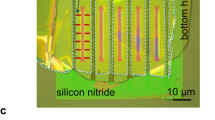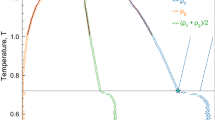Abstract
Liquid/vapour interfaces govern the behaviour of a wide range of systems but remain poorly understood, leaving ample margin for the exploitation of intriguing functionalities for applications. Here, we systematically investigate the role of liquid/vapour interfaces in the transport of water across apposing liquid menisci in osmosis membranes comprising short hydrophobic nanopores that separate two fluid reservoirs. We show experimentally that mass transport is limited by molecular reflection from the liquid/vapour interface below a certain length scale, which depends on the transmission probability of water molecules across the nanopores and on the condensation probability of a water molecule incident on the liquid surface. This fundamental yet elusive condensation property of water is measured under near-equilibrium conditions and found to decrease from 0.36 ± 0.21 at 30 °C to 0.18 ± 0.09 at 60 °C. These findings define the regime in which liquid/vapour interfaces govern nanofluidic transport and have implications for understanding mass transport in nanofluidic devices, droplets and bubbles, biological components and porous media involving liquid/vapour interfaces.
This is a preview of subscription content, access via your institution
Access options
Subscribe to this journal
Receive 12 print issues and online access
$259.00 per year
only $21.58 per issue
Buy this article
- Purchase on Springer Link
- Instant access to full article PDF
Prices may be subject to local taxes which are calculated during checkout





Similar content being viewed by others
References
Vlassiouk, I., Kozel, T. & Siwy, Z. Biosensing with nanofluidic diodes. J. Am. Chem. Soc. 131, 8211–8220 (2009).
Fan, R. et al. DNA translocation in inorganic nanotubes. Nano Lett. 5, 1633–1637 (2005).
Siria, A. et al. Giant osmotic energy conversion measured in a single transmembrane boron nitride nanotube. Nature 494, 455–458 (2013).
Brogioli, D. Extracting renewable energy from a salinity difference using a capacitor. Phys. Rev. Lett. 103, 058501 (2009).
Han, J. & Craighead, H. Separation of long DNA molecules in a microfabricated entropic trap array. Science 288, 1026–1029 (2000).
Zeng, Y. & Harrison, D. Self-assembled colloidal arrays as three-dimensional nanofluidic sieves for separation of biomolecules on microchips. Anal. Chem. 79, 2289–2295 (2007).
Kim, S., Ko, S., Kang, K. & Han, J. Direct seawater desalination by ion concentration polarization. Nature Nanotech. 5, 297–301 (2010).
Karnik, R. et al. Electrostatic control of ions and molecules in nanofluidic transistors. Nano Lett. 5, 943–948 (2005).
Vlassiouk, I. & Siwy, Z. Nanofluidic diode. Nano Lett. 7, 552–556 (2007).
Wang, Y., Stevens, A. & Han, J. Million-fold preconcentration of proteins and peptides by nanofluidic filter. Anal. Chem. 77, 4293–4299 (2005).
Holt, J. et al. Fast mass transport through sub-2-nanometer carbon nanotubes. Science 312, 1034–1037 (2006).
Tas, N., Mela, P., Kramer, T., Berenschot, J. & van den Berg, A. Capillarity induced negative pressure of water plugs in nanochannels. Nano Lett. 3, 1537–1540 (2003).
Duan, C., Karnik, R., Lu, M. & Majumdar, A. Evaporation-induced cavitation in nanofluidic channels. Proc. Natl Acad. Sci. USA 109, 3688–3693 (2012).
Lawson, K. & Lloyd, D. Membrane distillation. J. Membr. Sci. 124, 1–25 (1997).
Lee, J. & Karnik, R. Desalination of water by vapor-phase transport through hydrophobic nanopores. J. Appl. Phys. 108, 044315 (2010).
Cailliez, F., Stirnemann, G., Boutin, A., Demachy, I. & Fuchs, A. Does water condense in hydrophobic cavities? A molecular simulation study of hydration in heterogeneous nanopores. J. Phys. Chem. C 112, 10435–10445 (2008).
James, M. et al. Nanoscale condensation of water on self-assembled monolayers. Soft Matter 7, 5309–5318 (2011).
Tyrrell, J. & Attard, P. Images of nanobubbles on hydrophobic surfaces and their interactions. Phys. Rev. Lett. 87, 176104 (2001).
Qu, X. & Davis, E. Droplet evaporation and condensation in the near-continuum regime. J. Aerosol Sci. 32, 861–875 (2001).
Xiao, Z. et al. Fabrication of alumina nanotubes and nanowires by etching porous alumina membranes. Nano Lett. 2, 1293–1297 (2002).
Yanagishita, T., Nishio, K. & Masuda, H. Fabrication of metal nanohole arrays with high aspect ratios using two-step replication of anodic porous alumina. Adv. Mater. 17, 2241–2243 (2005).
Cath, T., Childress, A. & Elimelech, M. Forward osmosis: principles, applications, and recent developments. J. Membr. Sci. 281, 70–87 (2006).
Gryta, M. Osmotic MD and other membrane distillation variants. J. Membr. Sci. 246, 145–156 (2005).
Yan, R., Liang, W., Fan, R. & Yang, P. Nanofluidic diodes based on nanotube heterojunctions. Nano Lett. 9, 3820–3825 (2009).
Eames, I., Marr, N. & Sabir, H. The evaporation coefficient of water: a review. Int. J. Heat Mass Trans. 40, 2963–2973 (1997).
Clausing, P. Flow of highly rarefied gases through tubes of arbitrary length. J. Vac. Sci. Technol. 8, 636–646 (1971).
Cunningham, R. E. & Williams, R. J. J. Diffusion in Gases and Porous Media (Plenum, 1980).
Chapman, S., Cowling, T. G. & Burnett, D. The Mathematical Theory of Non-Uniform Gases; An Account of the Kinetic Theory of Viscosity, Thermal Conduction and Diffusion in Gases 3rd edn (Cambridge Univ. Press, 1970).
Demarcus, W. & Hopper, E. Knudsen flow through a circular capillary. J. Chem. Phys. 23, 1344 (1955).
Berman, A. Free molecule transmission probabilities. J. Appl. Phys. 36, 3356 (1965).
Winkler, P. et al. Mass and thermal accommodation during gas–liquid condensation of water. Phys. Rev. Lett. 93, 075701 (2004).
Marek, R. & Straub, J. Analysis of the evaporation coefficient and the condensation coefficient of water. Int. J. Heat Mass Trans. 44, 39–53 (2001).
Delaney, L., Houston, R. & Eagleton, L. The rate of vaporization of water and ice. Chem. Eng. Sci. 19, 105–114 (1964).
Li, Y. et al. Mass and thermal accommodation coefficients of H2O(g) on liquid water as a function of temperature. J. Phys. Chem. A 105, 10627–10634 (2001).
Mason, E. A. & Malinauskas, A. P. Gas Transport in Porous Media: The Dusty-Gas Model (Elsevier, 1983).
Jackson, R. Transport in Porous Catalysts (Elsevier Scientific, 1977).
Krishna, R. & Wesselingh, J. Review article number 50 — the Maxwell–Stefan approach to mass transfer. Chem. Eng. Sci. 52, 861–911 (1997).
Remick, R. & Geankoplis, C. J. Binary diffusion of gases in capillaries in the transition region between Knudsen and molecular diffusion. Ind. Eng. Chem. Fund. 12, 214–220 (1973).
Remick, R. & Geankoplis, C. J. Ternary diffusion of gases in capillaries in the transition region between Knudsen and molecular diffusion. Chem. Eng. Sci. 29, 1447–1455 (1974).
Yip, N., Tiraferri, A., Phillip, W., Schiffman, J. & Elimelech, M. High performance thin-film composite forward osmosis membrane. Environ. Sci. Technol. 44, 3812–3818 (2010).
Bonacci, J., Myers, A., Nongbri, G. & Eagleton, L. The evaporation and condensation coefficient of water, ice and carbon tetrachloride. Chem. Eng. Sci. 31, 609–617 (1976).
Mills, A. & Seban, R. Condensation coefficient of water. Int. J. Heat Mass Trans. 10, 1815–1827 (1967).
Mozurkewich, M. Aerosol growth and the condensation coefficient for water: a review. Aerosol Sci. Technol. 5, 223–236 (1986).
Hagen, D. et al. Condensation coefficient measurement for water in the UMR cloud simulation chamber. J. Atmos. Sci. 46, 803–816 (1989).
Maerefat, M., Akamatsu, T. & Fujikawa, S. Non-equilibrium condensation of water and carbontetrachloride vapour in a shock-tube. Exp. Fluids 9, 345–351 (1990).
Shaw, R. & Lamb, D. Experimental determination of the thermal accommodation and condensation coefficients of water. J. Chem. Phys. 111, 10659–10663 (1999).
Davidovits, P. et al. Mass accommodation coefficient of water vapor on liquid water. Geophys. Res. Lett. 31, L22111 (2004).
Ishiyama, T., Yano, T. & Fujikawa, S. Molecular dynamics study of kinetic boundary condition at an interface between a polyatomic vapor and its condensed phase. Phys. Fluids 16, 4713–4726 (2004).
Meland, R., Frezzotti, A., Ytrehus, T. & Hafskjold, B. Nonequilibrium molecular-dynamics simulation of net evaporation and net condensation, and evaluation of the gas-kinetic boundary condition at the interphase. Phys. Fluids 16, 223–243 (2004).
Jungwirth, P. & Tobias, D. Specific ion effects at the air/water interface. Chem. Rev. 106, 1259–1281 (2006).
Acknowledgements
The authors thank T. Humplik for assistance with X-ray diffraction analysis, N. Milkovic for environmental SEM, J. S. Jeon for confocal microscopy and F. Rahman for helpful discussions. This work was funded by King Fahd University of Petroleum and Minerals in Dhahran, Saudi Arabia, through the Center for Clean Water and Clean Energy at MIT and KFUPM (project no. R10-CW-09). This work made use of the MRSEC Shared Experimental Facilities supported by the National Science Foundation (NSF, award no. DMR-0819762), the Harvard Center for Nanoscale Systems (CNS), a member of the National Nanotechnology Infrastructure Network (NNIN) that is supported by the NSF (award no. ECS-0335765) and the Institute of Soldier Nanotechnologies at MIT.
Author information
Authors and Affiliations
Contributions
J.L. and R.K. conceived and designed the experiments. J.L. performed the research. J.L., T.L. and R.K. analysed the data and discussed the results. J.L. and R.K. wrote the manuscript.
Corresponding author
Ethics declarations
Competing interests
The authors declare no competing financial interests.
Supplementary information
Supplementary information
Supplementary Information (PDF 2464 kb)
Rights and permissions
About this article
Cite this article
Lee, J., Laoui, T. & Karnik, R. Nanofluidic transport governed by the liquid/vapour interface. Nature Nanotech 9, 317–323 (2014). https://doi.org/10.1038/nnano.2014.28
Received:
Accepted:
Published:
Issue Date:
DOI: https://doi.org/10.1038/nnano.2014.28
This article is cited by
-
Water pumping effect over the organic ions defined graphene oxide membrane impulses high flux desalination
npj Clean Water (2022)
-
Hydrophilicity gradient in covalent organic frameworks for membrane distillation
Nature Materials (2021)
-
Perspectives and design considerations of capillary-driven artificial trees for fast dewatering processes
Scientific Reports (2021)
-
Evaporation-driven transport-control of small molecules along nanoslits
Nature Communications (2021)
-
Continuous water-water hydrogen bonding network across the rim of carbon nanotubes facilitating water transport for desalination
Nano Research (2021)



